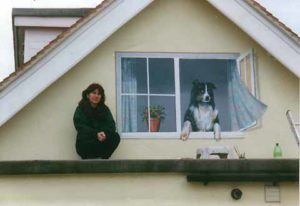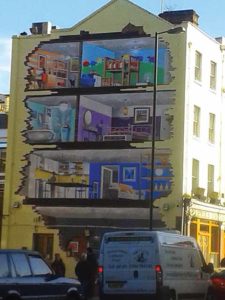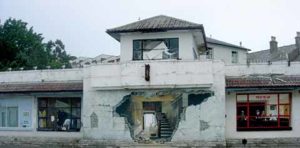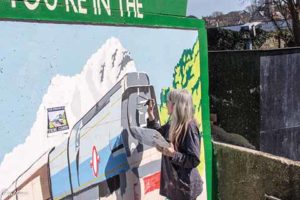Unless my eyes deceive me – Nina Camplin
Nick Churchill talks to Nina Camplin
Published in November ’17
Rarely has fake been so fashionable – from fake news to fake tans, faux is determinedly à la mode. All of which causes some amusement for Poole-based trompe l’œil artist Nina Camplin, who has made the art of faking it into something positively authentic since moving to Dorset at the turn of the century.
‘Within a few months of coming here from Luton, I painted the dog in the window mural in Swanage and have since re-painted it three times – I’ve had more work from that one mural than anything else I’ve done,’ she explains on a brief walking tour of her more visible works. ‘Swanage seemed to take me to its heart and I was asked to do work at Jonathan Ross’s house as a result of the dog in the window. I’ve lost count of how many views of Old Harry Rocks I’ve painted on garden walls that don’t quite have the sea views the owners wanted.’
The work at Cauldron Barn included carrying out some stencilling that Mrs Ross, the screenwriter and producer Jane Goldman, had planned in the garden room, some hand-painted design work in the bedrooms and disguising exterior pipework to blend in with the building’s stone walls.
She has also created murals for less stellar clients including Putlake Farm, Quay Foyer in Poole, Farmer Palmer’s, Chococo and Swanage Railway, where earlier this year she re-created a vintage Strong’s Brewery poster in the engine yard on the approach to Swanage station. ‘I think they need murals like that on all their stations now,’ she laughs.
Arguably Nina’s best-known work is the mural she made with Antonia Phillips at Swanage Pier Head. First painted for Purbeck Art Weeks in 2007 as the building awaited demolition, a decade later it clings to the rendered frontage even as the old door frame re-asserts itself from behind the plaster. ‘The Pier Head mural attracted an awful lot of publicity at the time and people have really taken to it since. I don’t know if proud is the right word to describe how I feel about it, but I love the fact that people interact with it and I’m always seeing photos of it posted on Flickr and social media. It was only meant to be up for a few months, so it’s slightly strange that it’s here at all really.’
Nina and Antonia made the Pier Head mural after Nina decided she wanted to take part in Purbeck Art Weeks but didn’t want to exhibit in a traditional gallery or open studio setting. ‘I’d not long completed a Fine Art degree, which only confirmed my feelings about galleries – that they tend to exclude people and a lot of work becomes more about the concept than the actual picture. So I was looking for a way to contribute and Antonia suggested we put on an event. She knew the owner of the building and they rendered the frontage and left us to it.
‘The thing I love about murals like this is what puts a lot of artists off – I like working in public. People come up and give their suggestions or ask to be put in the work; it’s very interactive. I’m not an artist who likes to be shut up in a studio so that nobody can see what I’m making. And once it’s done, it’s there for everyone. I might go back and re-touch it but I have no ownership of it once it’s finished.’
The Pier Head – complete with the re-creation of Michelangelo’s ‘Creation of Adam’, made in panels as a project with Poole and East Dorset Art Society – put Nina’s work prominently in the public eye and helped secure her a major commission to paint a four-storey broken wall mural on the side of a house for a leading paint manufacturer. ‘Their PR executive was on holiday in Swanage, saw the mural, made a note of my name and called me. That was quite a job – I seem to spend a lot of time working on skylifts, which is fine except you can’t take a step back and have a look at how the piece is coming along.’

Nina and ‘Donut’, the dog in the window, from the first incarnation of her mural in Gilbert Road, Swanage
In practice, Nina will map out a mural as a scale version for client approval then execute the plan using a grid system. She says she doesn’t really know how it works, only that it does. She has a feel for it, an innate sense of the art form, but when pressed reveals something of its technical side. ‘It’s about extending space that isn’t there into a false reality, so you have to know about viewing points, how to make perspective work and how to get the light right, otherwise the picture won’t work. You also have to know what paint will work on each surface. The dog in the window mural is in Gilbert Road and the acid from the steam trains wears the paint off so every five years or so I have to go back and re-paint it. When I made the mural for Swanage Railway, they paid to have a resin coat painted on that should protect it for longer.’

The mural on the side of a house in Clerkenwell Road, London that Nina created for paint manufacturer Valspar
In recognition of the overlap between creating murals and street art, Nina embarked on a project painting images of dogs in locations across Dorset, but she doesn’t see herself as a graffiti artist. ‘I’ve studied a lot of what Banksy does, but my twist was that I always got permission before I painted on a wall. Most of the dog images have gone now, but they were like my signature works for a while.’
The exigencies of earning a living from art being what they are, Nina’s practice also encompasses pet portraits, other commission work, even face painting, but she has also started painting her own canvasses again. ‘They’re canvasses that have already been used that I buy second-hand or are given to me. I’m doing wildlife pictures but only painting on part of the canvas, then whitewashing and sanding back the original artwork to blend it in. It’s early days but I’m quite pleased with them – if I can find the right space that isn’t a gallery, I might even exhibit again.’
www.ninacamplin.com




